A visit to the Dominican Republic
Sachiko Namba (curator)
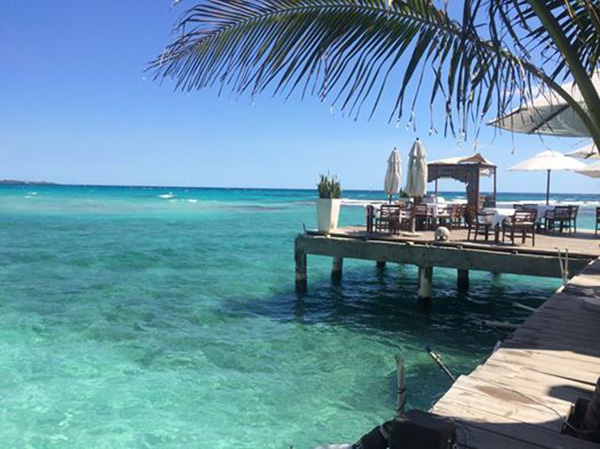
View from a restaurant looking out on the Caribbean Sea
The touring exhibition Passage to the Future: Art from a New Generation in Japan was held in the Dominican Republic's capital city of Santo Domingo from February 20 to March 30, 2014. Accompanying the exhibition, The Japan Foundation dispatched Sachiko Namba, who is active as a curator, to the city, where she gave lectures on the latest developments in Japanese contemporary art for the general public, as well as art professionals.
So, what were Ms. Namba's impressions of traveling to the Dominican Republic, where Japanese contemporary art is still largely unknown, and of visiting its art museums and interacting with its people? We asked her to contribute an account of her trip.
An exhibition of Japanese contemporary art in the Dominican Republic
Accompanying the holding of The Japan Foundation's touring exhibition Passage to the Future: Art from a New Generation in Japan in the Dominican Republic's capital city of Santo Domingo, I was asked by the foundation to give lectures on Japanese contemporary art, and had the opportunity to visit the city from March 3 to 7, 2014. This was my first-ever visit to the country, and with the cooperation of the Embassy of Japan there, I drew up a schedule that used time between two lectures to cram in visits to as many local art museums as possible and to interact with people in the art field. In that respect it was a whirlwind visit, but in the interest of making the most of the opportunity I would like to provide a report on the art scene in the Dominican Republic, which is generally not well known in Japan.
The Passage to the Future exhibition was planned by The Japan Foundation in 2004 to present works from its contemporary art collection. The exhibition showcases contemporary Japanese art from the latter half of the 1990s and later, including paintings, photographs, videos, sculptures and installations, and is travelling around the world. The goal of my lectures was to explain the works in this exhibition and about the artists who created them in an easy-to-understand manner to the people of the Dominican Republic, who are not familiar with Japanese contemporary art, as well as to discuss trends in Japanese contemporary art that have become prominent over the last 10 years or so, by referring to exhibitions I have been involved with as examples. In the lectures I discussed what sorts of trends had emerged in Japanese contemporary art within the flow of globalization from the 1990s, what those trends had in common with examples in other countries, and I highlighted which movements were unique to Japan by assembling keywords such as anime/manga, wabi-sabi, ma (interval/pause), handwork, everyday, participatory, and cross-disciplinary. At the beginning of the lectures I displayed images of Japanese manga and anime as I spoke, and it was clear that participants were familiar with the images, with some able to cite the names of the characters one after another. During the question and answer sessions, a Dominican artist remarked: "the colors of culture, which represent our roots, even amid the drift toward globalization, surface in the art of each country as individual characteristics, and this is empathetic" Additionally, following a lecture at the Galería Nacional de Bellas Artes, I also attended a meeting with people involved in the local art scene, which gave me the opportunity to exchange information about the art scene in Japan and the Dominican Republic.

(Left) A view of the Passage to the Future exhibition (the Galería Nacional de Bellas Artes)
(Right) The exterior of the Palacio de Bellas Artes
Visits to three art museums
The touring exhibition was shown at the Galería Nacional de Bellas Artes, a national art museum created by re-modelling a Neoclassical building that was formerly a palace. In addition to an art museum, the 13,000 square-meter site is also home to a theater, which boasts a national ballet company and orchestra. The art museum section is divided across two floors of exhibition rooms positioned around a central dome, and it regularly hosts exhibitions of domestic and international art. When I visited, The Japan Foundation's touring exhibition was being shown on the second floor, while on the first floor a group exhibition of photographs by Dominican artists showing a variety of local women was being held. During my stay I was able to visit two other art museums in Santo Domingo in addition to the Galería Nacional de Bellas Artes.
The first was the Museo Bellapart, a private art museum that shows works from the private collection of local Honda dealer Juan José Bellapart to the public. The first floor of the building contains a Honda showroom and at first glance you wonder where the art museum is, but inside, an elevator takes you to the fifth floor where a spectacular art museum awaits. The permanent collection exhibition room is laid out in a way you can trace the history of the art of the Dominican Republic, and the director of the museum, Myrna Guerrero Villalona, was kind enough to show me around.
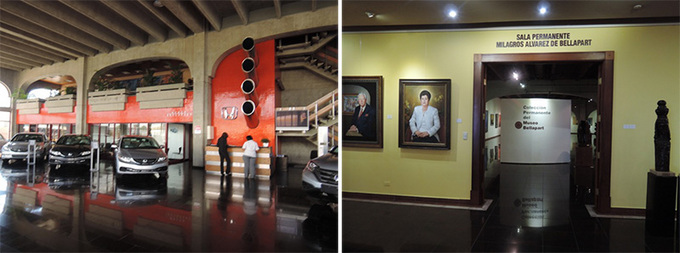
(Left) The Honda showroom on the first floor of the building housing the Museo Bellapart
(Right) The entrance to the permanent collection exhibition room at the Museo Bellapart. The portraits to the left of the entrance show Mr. and Mrs. Bellapart.
In the Dominican Republic, from before the war, oil paintings in the Romanticism and Neoclassical styles that might have been seen at European art academies were being actively painted by self-taught painters. However, in 1942 an art academy was set up in Santo Domingo, chiefly by artists who moved to the Dominican Republic from locations throughout Europe in order to escape the Spanish Civil War (1936-39). Rather than providing a uniform-type art education, this academy offered a liberal-type art program in which artists were encouraged to pursue their own distinct styles, and it consequently gave rise to a large number of unique Dominican artists who were not bound by any one style. In fact, the styles of the works in the collection at the Museo Bellapart included Cubism, Surrealism and German Romanticism, and in all cases the quality of the works was extremely high. In addition to the permanent collection, the museum also regularly themed exhibitions from the collection.
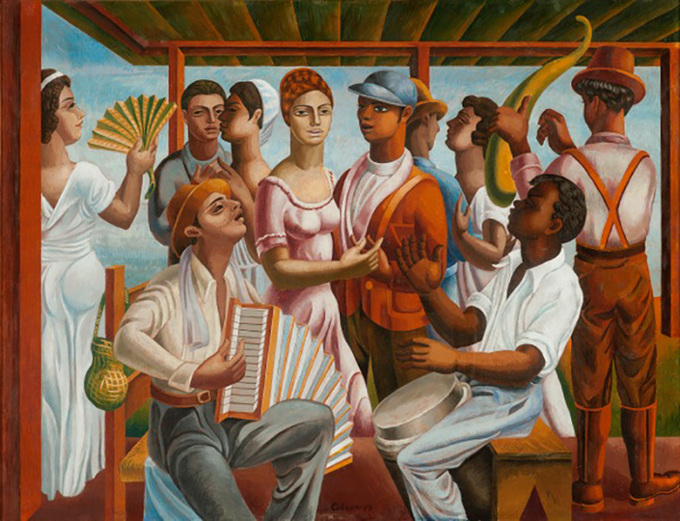
A work by Jaime Colson (1901-1975), one of the Dominican Republic's representative painters. The work depicts a Dominican Merengue dance.
Jaime Colson
Merengue
1937
Óleo sobre tela
52 x 68 cm
Collection of Museo Bellapart
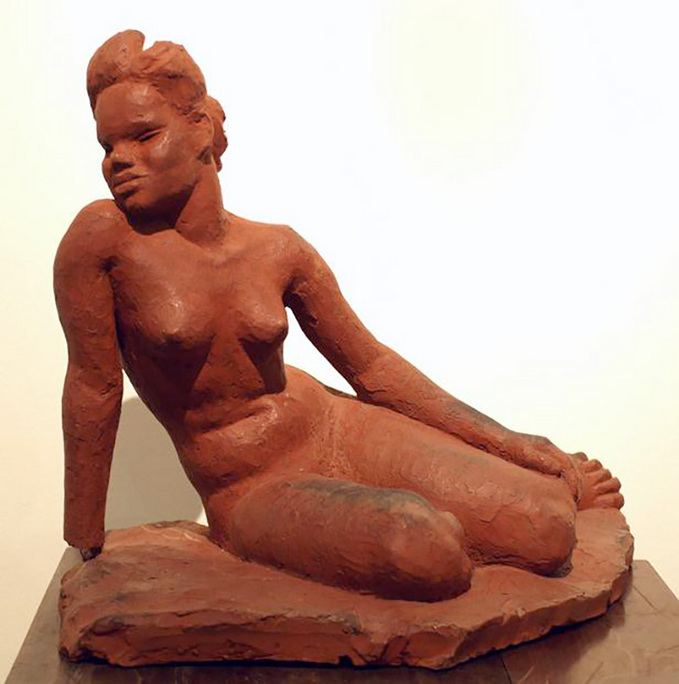
A sculpture from 1940 by Dominican female artist Celeste Woss y Gil (1891-1985). Her choice of the female nude as a subject matter was a scandal in the Dominican Republic at the time, but as she was the daughter of the country's president, even bold expressions such as this were forgiven.
Celeste Woss y Gil
Modelo mulata
1940
Barro
34.5 x 51 x 26 cm
Collection of Museo Bellapart
The second art museum I visited was the Museo de Arte Moderno, a four-floor complex comprising a basement, and three floors above ground. In addition to showing a rich collection of modern Dominican art, it also holds themed exhibitions. My visit coincided with the opening of a solo exhibition by Jorge Pineda, one of the Dominican Republic's premiere artists. The opening attracted a considerable turnout from members of the press and people involved in the art scene, and gave me a real sense of the depth in the local art community. Like many other Dominican artists who underwent art education in Europe and the United States , Jorge Pineda has been active internationally. The riveting exhibition featured drawings and installations that referenced Western art history and discourse. After visiting these three art museums, I could not help thinking that it would not be long before Dominican modern and contemporary art, which is of high quality and deeply reflective of the country's cultural history, achieves greater recognition in Japan.
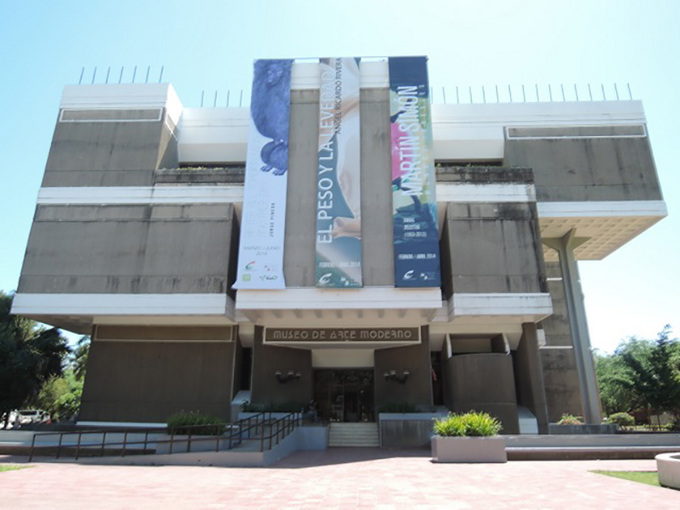
Museo de Arte Moderno
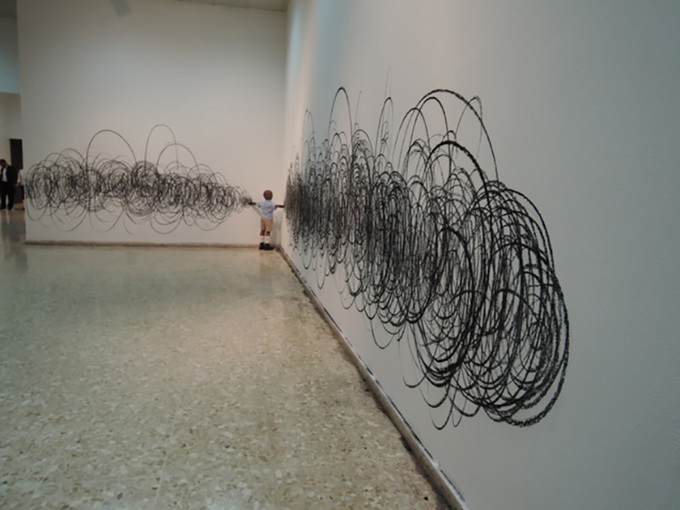
A work by Jorge Pineda. A sculpture of a child is positioned between two walls scrawled with drawings, creating the illusion that the child is scribbling on the walls.
Jorge Pineda
*Me voy: Sur*
2006
Installation
Wood carving, textiles, charcoal drawing on walls
Dimension variable
Collection of the Museo de Arte Moderno (Santo Domingo)
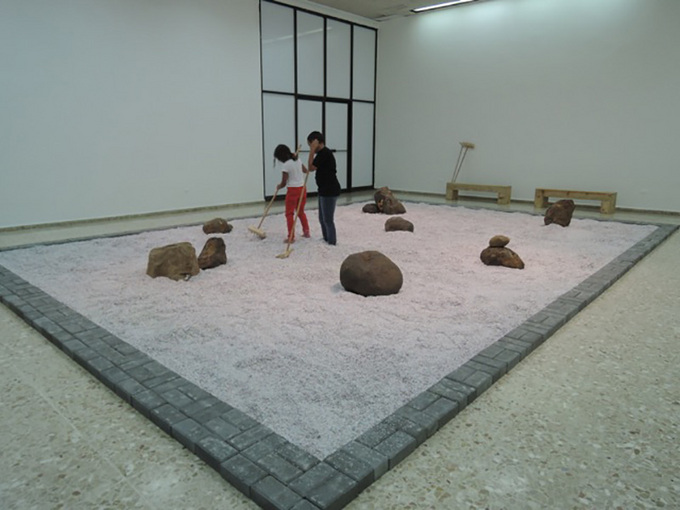
A work that pays tribute to Japan's Ryoan-ji temple's rock garden. The area representing small white pebbles consists of a blanket of confetti, like that used in weddings. The artist interpreted the stone garden as depicting ideal happiness achieved when the mind is emptied during meditation, and transformed it into an artwork that provides a starting point for considering what happiness means today.
Jorge Pineda
*I´m so fucking happy*
2013
Installation
Concrete blocks, wood, confetti, rocks
5 x 10 m
Collection of the artist
While I was visiting the Museo de Arte Moderno on the last day of my stay in the Dominican Republic, a group of junior high school students dressed in uniforms emerged from an exhibition room. I was watching this scene absentmindedly and thinking that in the Dominican Republic the schools take students on art museum tours, like other countries, when one of the students -- a young-faced boy -- stepped up to me, plonked his hand on my right shoulder and said hello. I was a bit taken aback by the sudden greeting but he asked me in English, "Are you Japanese?" I replied that I was, and a moment later he returned with a girl who I assume was a classmate and declared: "She loves Japan." The girl did not say anything, she just laughed with embarrassment, but I thanked her anyway. I was unable to ask them what their image of Japan was, but at the very least I was happy to discover that among young people in the Dominican Republic, some are interested in Japan. Above all else, I left the Dominican Republic wanting to learn more about the country, and, if I have the chance, to return and see their refreshing smiling faces again, as clear as the Caribbean Sea.
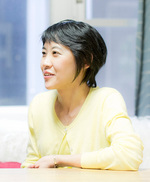 Sachiko Namba
Sachiko Namba
Curator. After working as a curator at the Museum of Contemporary Art Tokyo, Sachiko Namba set up I plus N Ltd., which undertakes the planning and running of contemporary art exhibitions and workshops. Major exhibitions she has organized include Garden for Children (Museum of Contemporary Art Tokyo, 2010), and Breathing Atolls: Japan-Maldives Contemporary Art Exhibition (The National Art Gallery of Maldives, Male, the Maldives, 2012). She authored Gendai kyureta to iu shigoto (Curating Contemporary Art in Japan: 1950s to the Present), Biennaare no genzai (Biennale Today, co-author/editor) and other books. She is Curatorial Project Manager for the Sapporo International Art Festival 2014 and curator for the Yokohama Paratriennale 2014.
(Photo:Kenichi Aikawa)
Back Issues
- 2024.11. 1 Placed together, we …
- 2024.5.24 The 50th Japan Found…
- 2024.5.24 The 50th Japan Found…
- 2024.2.19 Movie Theaters aroun…
- 2024.2.19 Movie Theaters aroun…
- 2023.4.24 The 49th Japan Found…
- 2022.10.24 Inner Diversity <2> …
- 2022.10. 5 Living Together with…
- 2022.6.13 The 48th Japan Found…
- 2022.6. 3 The 48th Japan Found…

